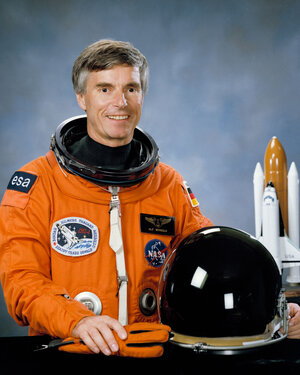Spacelab International Microgravity Lab IML-1
STS-42 was a flight of the Space Shuttle Discovery Liftoff was originally scheduled for 8:45 EST (13:45 UTC) 22 January 1992, but the launch was delayed due to weather constraints.
Discovery successfully lifted off an hour later at 9:52 EST (14:52 UTC). The main goal of the mission was to study the effects of microgravity on a variety of organisms. The shuttle landed at 8:07 PST (16:07 UTC) on 30 January 1992 on Runway 22, Edwards Air Force Base, California.
STS-42 was the first of two flights in 1992 of Discovery, the second of which occurred during STS-53, which launched on 2 December 1992. The mission was also the last mission of the Space Shuttle Discovery to have a seven-member crew until STS-82, which was launched on 11 February 1997.
MISSION STATISTICS
Mission name: STS-42
Shuttle: Discovery
Number of crew members: 7
Launch:
22 January 1992, 09:52:33 EST (14:52:33 UTC)
Landing:
30 January 1992, 08:07:17 PST, (16:07:17 UTC)
Duration: 8 days, 1 hour, 14 minutes, 44 seconds
Number of orbits: 129
CREW
The crew of STS-42 included West Germany's first astronaut, Ulf Merbold, and Canada's first woman astronaut, Roberta Bondar. In order to allow around-the-clock monitoring of experiments, the astronauts were divided into a red team and a blue team.
- Ronald J. Grabe (3), Commander (blue team)
- Stephen S. Oswald (1), Pilot (blue team)
- Norman E. Thagard (4), Mission Specialist 1 (blue team)
- David C. Hilmers (4), Mission Specialist 2 (red team)
- William F. Readdy (1), Mission Specialist 3 (red team)
- Roberta L. Bondar (1), Payload Specialist 1 - Canada (blue team)
- Ulf Merbold (2), Payload Specialist 2 - ESA Germany (red team)
(1) number of spaceflights each crew member has completed, including this mission

MISSION HIGHLIGHTS
Carried into orbit the International Microgravity Laboratory-1 (IML-1), a pressurized manned Spacelab module, to explore in depth the complex effects of weightlessness on living organisms and materials processing.
The international crew, divided into Red and Blue teams, conducted experiments on the human nervous system's adaptation to low gravity and the effects of microgravity on other life forms such as shrimp eggs, lentil seedlings, fruit fly eggs and bacteria. Low gravity materials processing experiments included crystal growth from a variety of substances such as enzymes, mercury iodine and a virus.
Other payloads included 10 Get Away Special (GAS) canisters, a number of middeck payloads and two Shuttle Student Involvement Program (SSIP) experiments. Middeck payloads included Gelation of SOLS: Applied microgravity research (GOSAMR), Investigations into Polymer Membrane Processing (IPMP) and the Radiation Monitoring Experiment (RME-III).
Landing: 30 January 1992, 8:07:17 a.m. PST, Runway 22, Edwards Air Force Base, CA., Rollout distance: 9 811 feet. Mission extended one day for continued scientific experimentation. Orbiter returned to KSC on 16 February 1992. Landing Weight: 218 016 lb (98.890 Mg).















 Germany
Germany
 Austria
Austria
 Belgium
Belgium
 Denmark
Denmark
 Spain
Spain
 Estonia
Estonia
 Finland
Finland
 France
France
 Greece
Greece
 Hungary
Hungary
 Ireland
Ireland
 Italy
Italy
 Luxembourg
Luxembourg
 Norway
Norway
 The Netherlands
The Netherlands
 Poland
Poland
 Portugal
Portugal
 Czechia
Czechia
 Romania
Romania
 United Kingdom
United Kingdom
 Slovenia
Slovenia
 Sweden
Sweden
 Switzerland
Switzerland




























